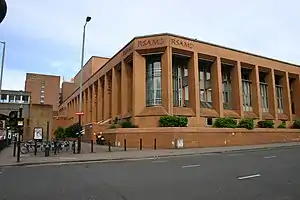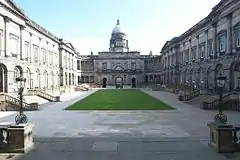Royal Conservatoire of Scotland
The Royal Conservatoire of Scotland (Scottish Gaelic: Conservatoire Rìoghail na h-Alba), formerly the Royal Scottish Academy of Music and Drama, is a conservatoire of dance, drama, music, production and film in the centre of Glasgow, Scotland.[2] It is a member of the Federation of Drama Schools.[3]
Scottish Gaelic: Conservatoire Rìoghail na h-Alba | |
 Front facade of the conservatoire | |
| Type | Conservatoire |
|---|---|
| Established | 1993 – granted degree-awarding powers 1847 – Glasgow Athenaeum |
| President | Sir Cameron Mackintosh |
| Principal | Jeffrey Sharkey |
| Students | 1,280 (2018/19)[1] |
| Undergraduates | 910 (2018/19)[1] |
| Postgraduates | 365 (2018/19)[1] |
| Location | , |
| Colours | |
| Affiliations | Conservatoires UK, Associated Board of the Royal Schools of Music, University of St Andrews, Association of European Conservatoires, Conference of Drama Schools |
| Website | rcs.ac.uk |
 | |
Founded in 1847, it has become the busiest performing arts venue in Scotland with over 500 public performances each year. The current Principal is American pianist and composer Jeffrey Sharkey, the President is Sir Cameron Mackintosh, and the Patron is Prince Charles.
History
The Royal Conservatoire has occupied its current purpose-built building on Renfrew Street in Glasgow since 1988. Its roots lie in several organisations. Officially founded in 1847 as part of the Glasgow Athenaeum, from an earlier Educational Association grouping, music and arts were provided alongside courses in commercial skills, literature, languages, sciences and mathematics. Courses were open and affordable, including day classes for ladies, and the Athenaeum had a reading room, news room, library and social facilities. Apprentices could also be members. Rented accommodation was found in the Assembly Rooms, Ingram Street, with major lectures taking place in the City Halls. The chairman at its inaugural Grand Soiree in the City Halls in December 1847 was Charles Dickens when in his opening remarks he stated that he regarded the Glasgow Athenaeum as "an educational example and encouragement to the rest of Scotland". Its Dramatic Club was formed in 1886 a year before the institution moved to purpose built premises, inclusive of a major concert hall/theatre, in St George's Place close to West Nile Street, designed by architect John Burnet.[4]
In 1888, the commercial teaching separated to form the Athenaeum Commercial College, which, after several rebrandings and a merger, became the University of Strathclyde in 1964. The non-commercial teaching side became the Glasgow Athenaeum School of Music.
In 1893 additional premises linked through to Buchanan Street and included a new Athenaeum Theatre facing Buchanan Street designed by architect Sir John James Burnet. In 1928 the premises were substantially extended with a gift from the philanthropist Daniel Macaulay Stevenson. In 1929 the school was renamed as the Scottish National Academy of Music to better reflect its scope and purpose.[5] This major acquisition of space at the corner of St George's Place (later renamed Nelson Mandela Place) and Buchanan Street was the Liberal Club (now not required by that party), designed originally by architect Alexander Skirving and remodelled by architects Campbell Douglas and Paterson in 1907.[4][6]
Its principal from 1929 to 1941 was William Gillies Whittaker. In 1944, it became the Royal Scottish Academy of Music.
The Royal Scottish Academy of Music established a drama department called the Glasgow College of Dramatic Art during 1950. It became the first British drama school to contain a full, broadcast-specification television studio in 1962. In 1968 the Royal Scottish Academy of Music changed its name to the Royal Scottish Academy of Music and Drama (RSAMD) and introduced its first degree courses, which were validated by the University of Glasgow.
During 1987–88 the Academy moved to its present site some two hundred yards north in Renfrew Street at Hope Street, across from the Theatre Royal, the new building having been designed by architect Sir Leslie Martin with executive architects William Nimmo and Partners.[4][6]
In 1993 RSAMD became the first conservatoire in the United Kingdom to be granted its own degree-awarding powers. Research degrees undertaken at RSAMD are validated and awarded by the University of St Andrews .[7] RSAMD is one of four member conservatories of the Associated Board of the Royal Schools of Music.
Name change
From 1 September 2011, the RSAMD changed its name to the Royal Conservatoire of Scotland.[8] They decided on the name change after a long consultation process that involved the principal John Wallace and the Academy's board of directors, as well as past and present students and staff, arts & academic institutions, politicians, and the Royal Protocol Unit.
The principal said the new name was necessary to cover all fields that the institute offers, as it no longer is simply a music and drama academy. Undergraduate courses in areas such as Digital Film & Television, Production Arts and Design, Production Technology and Management, Musical Theatre and Modern Ballet (in partnership with Scottish Ballet) have been added to the degrees the Royal Conservatoire offers. He felt it was best to choose a name that was representative of all disciplines offered.[9]
In 2016 and 2017, QS Quacquarelli Symonds ranked it as one of the world's best institutions for Performing Arts in their global ranking of the discipline.[10]
Facilities
The Royal Conservatoire has a range of facilities, including several performance spaces: the Ledger Room, Stevenson Hall, the Chandler Studio Theatre, the New Athenaeum Theatre, and the Alexander Gibson Opera Studio (built in 1998, the first purpose built opera school in Britain). There are around 65 private practice rooms for music students, each equipped with a piano with stool, music stand and chairs. These include 11 rooms reserved solely for pianists, several rooms for use by the Scottish Music department, and 8 rehearsal and coaching rooms. The Royal Conservatoire also houses several professional recording studios, including a new studio in the Opera School for the use of large ensembles.
The Royal Conservatoire also has an automated flying system in its main performing venue, the New Athenaeum Theatre, meaning it has become the first educational establishment in the UK to offer Stage Automation Training as part of the curriculum.
In 2010, RCS opened its second campus near Cowcaddens, now known as the "Wallace Studios at Speirs Locks".[11] This building was designed by Malcolm Fraser. It opened predominantly to house the Modern Ballet and Production courses, as the Renfrew Street campus was struggling to accommodate the combination of new courses and higher intake levels. In 2014, a £2 million extension to this second campus was built, creating even more rehearsal spaces and improved facilities for the students.
The Royal Conservatoire's extensive archive of historical papers and ephemera charts both its own institutional history and the wider performance history of Scotland.
Schools
School of Music
- Brass
- Chamber Music
- Composition
- Conducting
- Education (Bachelors/PGDE)
- Guitar and Harp
- Historically Informed Performance Practice (Masters)
- Jazz
- Keyboard
- Opera (Masters)
- Piano Accompaniment
- Piano for Dance (Masters)
- Repetiteurship
- Scottish Music
- Strings
- Timpani and Percussion
- Traditional Music
- Traditional Music – Piping
- Vocal Studies
- Woodwind
School of Drama, Dance, Production and Film
- Acting
- Classical and Contemporary Text (Masters and Master of Fine Arts)
- Contemporary Performance Practice
- Filmmaking
- Performance in British Sign Language and English
- Production Arts and Design
- Production Technology and Management
- Musical Theatre
- Musical Theatre Performance (Masters)
- Musical Theatre Directing (Masters)
- Modern Ballet
Junior Conservatoire
- Junior Conservatoire of Music
- Junior Conservatoire of Drama
- Junior Conservatoire of Production
- Junior Conservatoire of Film
- Junior Conservatoire of Dance
Alumni
- Michael Angelis
- James Fullarton Arnott
- Stephen Ashfield
- Ani Batikian
- Maureen Beattie
- Fiona Bell
- Cora Bissett
- Iain Blair
- Christine Bottomley
- Billy Boyd
- Betsy Brandt
- Alison Brie
- Jack Bruce
- Isobel Buchanan
- Stuart Cassells
- Karen Cargill
- John Carlin
- Robert Carlyle
- Carrie Cracknell
- Tom Conti
- Nicholas Cowell
- Damian Cruden
- Alan Cumming
- Tony Curran
- Henry Ian Cusick
- Louise Delamere
- Kate Dickie
- Laura Donnelly
- Patrick Doyle
- Christopher Duncan
- Sheena Easton
- Valerie Edmond
- Emun Elliott
- Tom Ellis (actor)
- Lynn Ferguson
- Emma Fielding
- Gregor Fisher
- James Fleet
- Laura Fraser
- Ncuti Gatwa
- Alexander Gibson
- Michelle Gomez
- Stella Gonet
- Hannah Gordon
- Kevin Guthrie
- John Hannah
- David Hayman
- Ivan Heng
- Jeremy Herrin
- Sam Heughan
- Aneirin Hughes
- Tunji Kasim
- Colin Lamont
- Gary Lamont
- Denis Lawson
- Katie Leung
- Phyllis Logan
- Angela Lonsdale
- Jack Lowden
- Shauna Macdonald
- Richard Madden
- Rik Makarem
- Lauren Marcus
- Mary Marquis
- Angus MacPhail
- James McAvoy
- Colin McCredie
- Ian McDiarmid
- Greg McHugh
- David McVicar
- Anthony Michaels-Moore
- Colin Morgan
- Paul Leonard-Morgan
- Daniela Nardini
- Gray O'Brien
- Kevin O'Loughlin
- Ian Parker
- Bill Paterson
- Shernaz Patel
- Margaret Preece
- Nicholas Ralph
- Jenna Reid
- Ian Richardson
- Natalie J. Robb
- Anne Sharp
- Sean Shibe
- Alexandra Silber
- Elaine C Smith
- Dawn Steele
- Andrew Stevenson
- David Tennant
- Emily Smith
- Brian Vernel
- Svetlina Stoyanova
- Dougie Vipond
- Jonathan Watson
- Ruby Wax
- Matthew Whiteside
- Gareth Williams
- Krysty Wilson-Cairns
- Julie Wilson Nimmo
- Greg Wise
- Jayne Wisener
- Catriona Morison
Principals
- William G. Whittaker 1929 to 1941
- Ernest Bullock 1941 to 1952
- Henry Havergal 1953 to 1969[12]
- Kenneth Barritt 1969 to 1976[13]
- David Lumsden 1976 to 1982
- Philip Ledger 1982 to 2001
- John Wallace 2002 to 2014
- Jeffrey Sharkey 2014 to Present
See also
References
- "Where do HE students study?". Higher Education Statistics Agency. Retrieved 1 March 2020.
- "QS World University Rankings by Subject 2017 – Performing Arts". Top Universities. QS Quacquarelli Symonds. Retrieved 14 September 2017.
- Granger, Rachel. "Rapid Scoping Study on Leicester Drama School" (PDF). De Montfort University Leicester. Retrieved 7 September 2019.
- Royal Scottish Academy of Music and Drama, 150th Celebration, by Grace Matchett and Frank Spedding, published in 1997
- "Extension of premises". The Glasgow Herald. 9 June 1928. Retrieved 14 August 2016.
- "The Athenaeum, St George`s Place (renamed Nelson Mandela Place) off Buchanan Street, Glasgow". www.arthurlloyd.co.uk. Retrieved 23 January 2019.
- "Royal Conservatoire of Scotland – University of St Andrews". www.st-andrews.ac.uk. Retrieved 23 January 2019.
- RSAMD renaming Archived 30 April 2011 at the Wayback Machine
- Tumelty, Michael (4 July 2011). "Change the academy's name, but not its soul". Herald Scotland. Retrieved 14 August 2016.
- "QS World University Rankings by Subject 2016 – Performing Arts". Top Universities. QS Quacquarelli Symonds. Retrieved 14 September 2016.
- "Speirs Locks Studios". Retrieved 23 January 2019.
- "Death of former principal of scots music academy". Herald Scotland. 14 June 1989. Retrieved 9 October 2019.
- "Kenneth Barritt". Herald Scotland. 21 May 1997. Retrieved 9 October 2019.
External links
| Wikimedia Commons has media related to Royal Scottish Academy of Music and Drama. |

